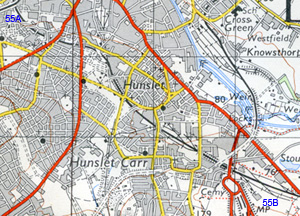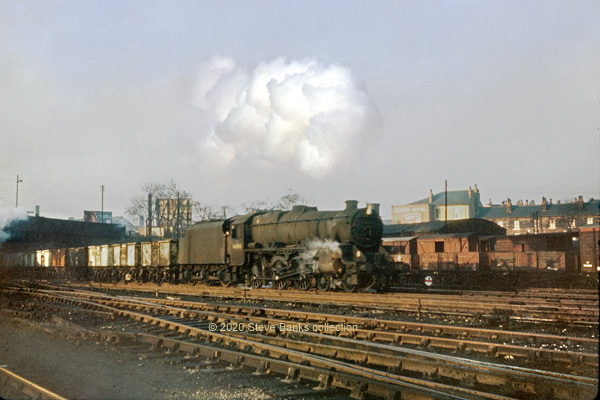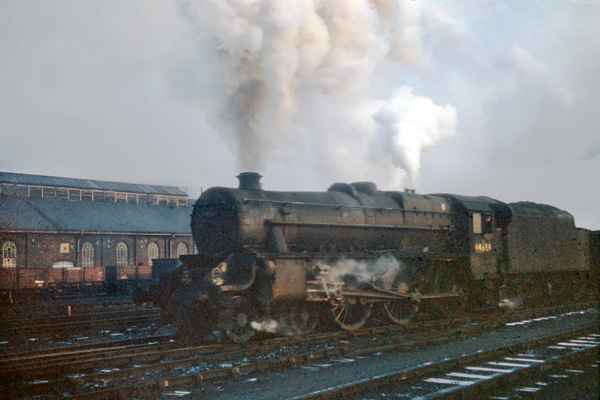Holbeck and Stourton
Several railways to Leeds approached from the south and the ex-LMS lines had three different ones. My focus this time is the former Midland Railway route which passed between Stourton and Holbeck. In between lay Hunslet and miles of yards and sidings and, at each end, an engine shed. Holbeck was primarily a shed for Leeds City station and populated by passenger and mixed traffic types. Stourton was smaller and mainly goods locos were stabled there. Pictures I took myself are under "Own photos".

An extract from the 1966 1" map of south Leeds with Holbeck shed 55A in the top LH corner and Stourton 55B in the lower RH corner. The two stations, Leeds City and Leeds Central, were just above the top left corner. The yards at Hunslet can be seen just right of centre, those at Stourton to the lower right. Source: Ordnance Survey.
Click on the image for an enlargement
Stourton
New additions placed here temporarily.
I've added this map to help show the location of these pictures. It's based on the NLS copies of the OS 25" maps for 1932-34, and please don't look too closely because the shed fell in the corner of four sheets and this is a best-possible composite. Goods yards dominated the area and the legend "Stourton Sidings" is for the whole area. The loco shed was quite modest with a single turntable running shed. Source: National Library of Scotland.
Click on the image for an enlargement

B1 No 61002 Impala was captured at Stourton c1965 when it would have been a York or Hull Dairycoates loco. Photo: Author's collection.
Click on the image for an enlargement
The next two are copied from the Stourton section of "1960s own photos":

On Saturday 3rd October 1964, I went down to Stourton on my push bike to see Flying Scotsman on a special, and was surprised to see a clean Britannia arrive light engine, No 70021 Morning Star. It was one of Cardiff Canton's that went to Willesden and, for a while, they worked an overnight/early morning fitted freight to Leeds.
Discussion has suggested that the loco was too large for the turntable at Stourton so was first sent to Holbeck for servicing. Turning could have been via the roundhouse, or by using the Whitehall triangle, which according to Keith Long who was a signalman at Engine Shed Junction Signal Box (Holbeck), was used for Gresley Pacifics. The turntables at Holbeck could certainly take a Britannia for I used to see them in the roundhouse and I would lean towards that option on grounds of convenience. When ready the loco was run down to Stourton and parked in the open yard in front of the shed for easy attachment to the return working from Hunslet.Photo: Steve Banks
Click on the image for a full-size version. Return by clicking the "x".

A final view of No 70021 Morning Star. I saw a few more at Stourton around this time but it was a relatively short-lived phase. Photo: Steve Banks.
Click on the image for a full-size version. Return by clicking the "x".
The final addition is copied from the "Signals and Signal Boxes" section.

Wakefield Rd. signal box was a Midland Railway design near Stourton, a mile or so south of Leeds City on the line to Derby and St.Pancras. The main signals controlled the line into Leeds, while the shunting arms covered sidings which I believe are still used today. 1976. Photo: Steve Banks
Click on the image for an enlargement

Many ex-LMS 4Fs were allocated to Stourton and used for local and transfer trips and, as seen here, with a load of empty coal wagons. Stourton's No 43931 is seen taking the avoiding between Hunslet and the Settle & Carlisle at Whitehall Junction. Code J lights are being carried (mineral or empty wagon train). The year was 1961 and while all-steel mineral wagons had been built in large numbers, wooden wagons were still in service and three 7-plank ones can be seen behind the tender.
Eventually, when Leeds Central was closed, the line from King's Cross was redirected into Leeds City via this junction. Photo: G.W. Morrison
Click on the image for an enlargement

A view by the sidings between Hunslet and Stourton with spring in the air, but also a lot of clag from "Austerity" No 90451 as it struggles to get away with a Code 7 loose-coupled express mineral train. It was a Goole (50D) loco. Photo: T. Spindler, author's collection.
Click on the image for an enlargement

Looking north again as a "Black Five", believed to be Newton Heath's No 44845 passes with a Class 7 Freight (unfitted, maximum speed 40 mph) with steel mineral wagons leading, impossible to tell if they are loaded or empty. January 1964. Photo: Trevor Spindler.
Click on the image for an enlargement

Wakefield's WD 2-8-0 No 90342 approaches light engine from the Hunslet direction. January 1964. Photo: Trevor Spindler.
Click on the image for an enlargement

Locos were still being shopped and this example, Stourton's 8F No 48641, is heading north light engine. January 1964. Photo: Trevor Spindler.
Click on the image for an enlargement

Another light engine movement and another Stourton loco, ex-LMS Ivatt 2-6-0 No 43075 catches almost the last of the sun. January 1964. Photo: Trevor Spindler.
Click on the image for an enlargement

With the sun beginning to fade, No 44889, a "Black Five" from Lancaster Green Ayre, approaches with a Class 6 Express Freight (not less than 20% AVB, maximum speed 45 mph). January 1964. Photo: Trevor Spindler.
Click on the image for an enlargement

Another wintry view in 1964 as Thompson B1 No 61327, allocated to Sheffield, Tinsley (41A), runs off the goods line onto the main with a Code 5 express freight (50% wagons with AVB). The destination could have been a yard at Hunslet or Neville Hill. Photo: T. Spindler, author's collection.
Click on the image for an enlargement

One of Stourton's 4Fs, No 44686, basks in a wintry sun in the shed yard. Photo: T. Spindler, author's collection.
Click on the image for an enlargement



